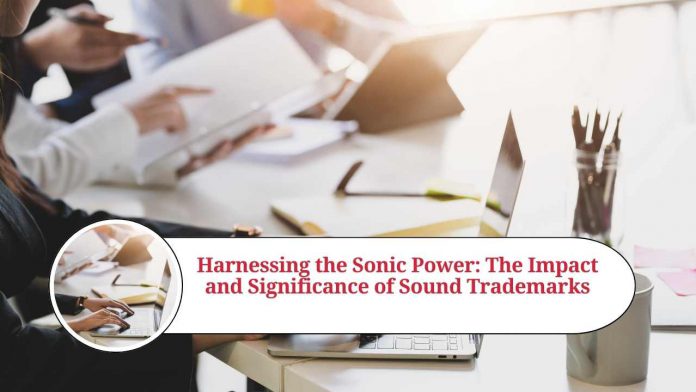Introduction
In today’s highly competitive business landscape, companies are constantly seeking innovative ways to stand out from the crowd and create a lasting impression on consumers. While visual branding elements like logos and color schemes have long been recognized as essential tools for brand recognition, there is another sensory dimension that holds immense potential: sound. Sound trademarks, also known as audio logos or sonic branding, are becoming increasingly popular as a means to establish a unique auditory identity that resonates with customers. In this blog post, we’ll delve into the world of sound trademarks and explore their significance in modern marketing.
Defining Sound Trademarks
A sound trademark is a distinctive sound or sequence of sounds that serves as an identifier of the source of a product or service. Similar to visual trademarks, sound trademarks aim to create a unique association with a brand, enhancing its recognition and recall in the minds of consumers. The most recognizable sound trademarks are often short, simple, and evoke specific emotions or values linked to the brand.
Examples of Sound Trademarks
Some of the most iconic sound trademarks include:
- Intel: The five-note jingle played at the end of their advertisements has become synonymous with the brand, making it instantly recognizable worldwide.
- Nokia: The Nokia tune is a classic example of a sound trademark. Its simple and catchy melody has been associated with the brand since the early days of mobile phones.
- McDonald’s: The “I’m Lovin’ It” jingle has been a staple of McDonald’s advertising campaigns, leaving a lasting impact on listeners.
- Netflix: The short, resonating “ta-dum” sound that plays at the beginning of Netflix original shows has become synonymous with the streaming giant.
Benefits of Sound Trademarks
- Brand Differentiation: In a crowded marketplace, a distinctive sound trademark can help a brand stand out and be remembered by consumers more effectively than visual elements alone.
- Emotional Connection: Sound has a powerful emotional impact on humans. By creating a memorable sound trademark, brands can evoke specific emotions, helping forge deeper connections with their target audience.
- Increased Recall: Sound has a strong impact on memory. Associating a unique sound with a brand can improve recall, ensuring that customers remember the brand more easily when making purchasing decisions.
- Consistency Across Channels: Sound trademarks can be used consistently across various marketing channels, including TV and radio commercials, online videos, phone apps, and more. This consistency reinforces the brand identity and strengthens the overall brand experience.
Legal Considerations
To establish a sound trademark, companies must ensure that their sound is unique, non-functional, and capable of distinguishing their goods or services from others. This requires thorough research and legal guidance to avoid infringement on existing trademarks.
Conclusion
In an increasingly cluttered marketplace, brands must explore every avenue to capture the attention and loyalty of consumers. Sound trademarks offer a unique opportunity to create a lasting impression and differentiate a brand from its competitors. By carefully crafting a sonic identity that resonates with the target audience, companies can elevate their brand recognition, emotional connections, and overall brand experience. As the world becomes more connected and technologically advanced, sound trademarks will continue to play a crucial role in shaping the future of marketing and brand identity.
Read more useful content:
Frequently Asked Questions (FAQs)
What is a sound trademark?
A sound trademark is a unique sound or sequence of sounds that serves as an identifier of the source of a product or service.
How are sound trademarks different from visual trademarks?
Sound trademarks rely on auditory perception, while visual trademarks are based on visual recognition. Sound trademarks use distinctive sounds to create brand recognition and recall.
Can any sound be trademarked?
No, not every sound can be trademarked. To qualify for a sound trademark, the sound must be distinctive, non-functional, and capable of distinguishing the goods or services of one company from others.
How do sound trademarks benefit brands?
Sound trademarks provide brand differentiation, create emotional connections with consumers, enhance recall, and offer consistency across various marketing channels.
What is the process of registering a sound trademark?
The process of registering a sound trademark involves conducting a thorough search to ensure uniqueness, filing an application with the appropriate trademark office, and providing evidence of distinctiveness and non-functionality.
Can sound trademarks be international?
Yes, sound trademarks can be registered internationally through various procedures, such as filing individual applications in different countries or using the Madrid System for international trademark registration.
Are there any famous examples of sound trademarks?
Yes, there are many famous examples, including the Intel jingle, Nokia tune, McDonald’s “I’m Lovin’ It” jingle, and the Netflix “ta-dum” sound.
How long does a sound trademark last?
Sound trademarks can last indefinitely as long as the registration is renewed and the mark continues to be used in commerce.
Can sound trademarks be updated or modified?
Yes, sound trademarks can be updated or modified over time, but any changes should maintain the distinctive qualities that make the sound unique to the brand.
Are there any limitations or restrictions on sound trademarks?
Sound trademarks must adhere to legal requirements, such as not being generic or functional. Additionally, they should not infringe on existing trademarks or cause confusion among consumers.




















